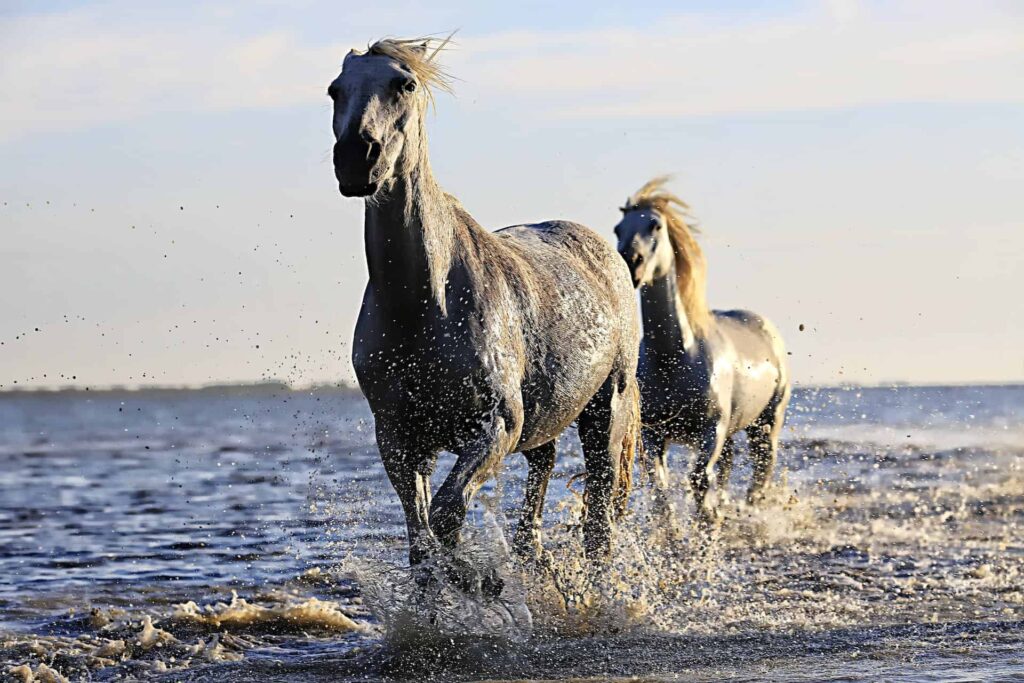Horses are known for their impressive physical abilities and strength, often utilized in various sporting activities and work tasks. A lesser-known fact is that horses can, in fact, swim. Their natural buoyancy and powerful limbs provide them with the capability to navigate through water when needed.
The physical attributes of horses, such as their long legs, strong muscles, and flexible spine, contribute to their swimming abilities. Beyond their natural ability to swim, there are various benefits of swimming for horses, such as being an excellent form of low-impact exercise that eases the strain on their joints and limbs. Furthermore, swimming can be incorporated as a significant complementary training method for horse conditioning and rehabilitation.
Key Takeaways
- Horses possess natural swimming abilities due to their physical characteristics
- Swimming provides low-impact exercise and can be used as an alternative training method
- Horse swimming can offer benefits such as improved conditioning and rehabilitation for injuries
The Natural Ability of Horses to Swim
Horses, both wild and domestic, possess a natural ability to swim. This instinctive behavior is often observed in equine species regardless of their breed. In the wild, horses may encounter bodies of water that they must traverse as part of their daily life, for example, to find food or escape from danger. As a result, their capability to swim is well-developed.
Domestic horses also maintain this intrinsic ability to swim. Owners and trainers often include swimming as part of a horse’s exercise routine, knowing that it aids in building muscle strength, stamina, and flexibility. A kinematic analysis of horses swimming has shown that swimming helps to strengthen the equine forelimb, providing insight into the importance of this activity for horses in general.
Equine behavior in water varies among horse breeds, with some breeds exhibiting greater comfort and skill in water than others. It’s important to understand that all horses are capable of swimming with their natural instinct. The key to successful swimming for domestic horses is proper training and acclimatization to water, ensuring that they feel comfortable and safe in the environment.
The natural ability of horses to swim is a significant aspect of their instincts and behavior, both in the wild and in domestic settings. As a form of exercise, swimming provides numerous physical benefits for horses and serves as a testament to their adaptability and resilience as a species.
Physical Characteristics Supporting Horse Swimming
Horses possess several physical characteristics that aid their ability to swim. For instance, while swimming, horses use their heads to maintain an optimal position and maintain visibility. Their head position determines their success in the water, as it helps them regulate their buoyancy and ensures they remain afloat.
The buoyancy of a horse plays an integral role in its ability to swim. The physical properties of water, such as increased buoyancy and hydrostatic pressure, help support the horse’s body in the water. This enables horses to stay afloat with less effort than they would need on land.
Horses also have powerful legs that contribute to their ability to swim. Their front legs propel them through the water, while their hind legs serve to maintain balance and control. These strong limbs allow the horse to generate enough force to keep its body afloat and to move through the water effectively.
The hindquarters also play a vital role in a horse’s swimming ability. They provide stability and propulsion to help the horse maintain a steady and rhythmic swimming motion. This is particularly important, as horses rely on their hindquarters for bursts of speed and power when needed.
Horses have relatively well-developed depth perception despite their monocular vision. This ability helps them gauge the distance between their bodies and the water surface, enabling them to adjust their motion accordingly to remain afloat and avoid submersion.
Several physical characteristics contribute to a horse’s ability to swim, such as head position, buoyancy, and the strength of their legs and hindquarters. Depth perception plays a role in helping them remain afloat and avoid submersion. These factors together provide horses with the ability to swim efficiently and adapt to an aquatic environment when necessary.

Benefits of Swimming for Horses
Swimming provides numerous benefits for horses, as it serves as an effective form of therapy, fitness, and exercise. When integrated into a horse’s training routine, swimming can significantly improve their overall athletic performance and endurance.
One of the primary advantages of swimming as a form of exercise for horses is the low-impact nature of the activity. Swimming alleviates the stress and strain typically placed on their joints and tendons during traditional ground exercises. This makes it an excellent rehab technique for horses recovering from injuries or surgeries, promoting faster healing while maintaining muscle tone.
Equine hydrotherapy, a type of therapy involving water, has been recognized for its effectiveness in muscle development and toning muscles. As horses swim, resistance from the water helps build muscle mass without the risk of overexertion or injury. This contributes to a stronger and more balanced musculoskeletal system, while simultaneously enhancing their flexibility and balance.
Swimming also benefits the respiratory system of horses. The increased demand for oxygen during this exercise helps improve the function of their heart and lungs. Improved respiratory health leads to enhanced cardiovascular health in horses, promoting longevity and the ability to perform at optimum levels.
Furthermore, swimming is an excellent exercise for horses experiencing respiratory issues or who may be prone to them due to issues like allergies. By reducing exposure to environmental triggers, horses can maintain their fitness levels while avoiding exacerbation of respiratory problems.
Incorporating swimming exercises into a horse’s routine can provide several benefits, from injury rehabilitation to muscle development and respiratory health, making it a wonderful addition to a comprehensive training program.
Swimming as a Training Method
Swimming has been increasingly recognized as an effective training method for horses. Many trainers have incorporated swimming exercises into their training schedules for various reasons.
Swim therapy offers numerous physical benefits to horses, particularly in terms of reducing muscle damage and avoiding tendon injuries. The weightless environment provided by water allows horses to effectively exercise their muscles without placing too much strain on their tendons and ligaments, which is particularly important for sport horses that often undergo intense training regimes.
Beyond preventing injuries, swimming also aids in the rehabilitation process for horses that have sustained muscle or tendon damage. The low-impact nature of swim training allows injured horses to gradually rebuild their strength and flexibility while minimizing the risk of further injury. The buoyancy of the water also helps to support the horse’s body weight, thereby providing a gentler form of exercise that causes minimal pain and discomfort.
Competency in swimming may vary among horses, but with the right guidance and training, most horses can become proficient swimmers. Trainers often start by introducing their horses to the water gradually, allowing them to become comfortable and confident in the water before beginning more advanced swim training exercises.
It’s important to emphasize that swimming should be incorporated as part of a well-rounded training program for horses. Incorporating a variety of different exercises, such as swimming, running, and strength training, allows horses to develop a balanced range of skills and physical abilities.
Swimming is a valuable training method for horses, offering numerous benefits such as reduced muscle damage, improved tendon health, and effective rehabilitation opportunities. By incorporating swim therapy into their training programs, trainers can help support the overall health, fitness, and performance of their horses.
Risks and Dangers Involved in Horse Swimming
Horse swimming can offer several benefits, such as building strength and stamina. However, there are risks and dangers that should be considered for both the horse and its handler.
Drowning is the most severe risk when swimming with horses. Although horses are natural swimmers, they can still drown if they become tired or panicked. Horses rely on their stamina to keep their heads above water, and if they exhaust their energy reserves, they may struggle to stay afloat.
Water currents can also pose a hazard for horses during swimming sessions. A sudden change in current or encountering a strong undertow can quickly lead to an unmanageable situation. Horses may struggle against the flow, further draining their energy, thus increasing the drowning risk.
Fear can play a significant role in horse swimming as well. A horse that is scared or anxious may panic in the water, leading to unpredictable behavior and increased risk. Inexperience and unfamiliarity with swimming can contribute to fear in horses. Gradual conditioning helps horses become acclimated to water environments.
Water depth is another critical factor to when allowing a horse to swim. The horse should be introduced to water gradually, starting with shallow water and progressively moving towards deeper water as the horse becomes comfortable and confident. Monitoring water depth during swimming sessions can help prevent accidents.
Resistance encountered in the water can both help and harm horses during swimming. While water resistance can help build muscles, over-exerting a horse can lead to injury or exhaustion. Monitor the horse’s energy levels and safely stop swimming sessions when they show signs of fatigue.
To minimize the risks and dangers involved in horse swimming, several safety tips can be followed:
- Know your horse’s abilities and limitations: Understand a horse’s swimming capability, take note of their fitness, and plan swimming sessions accordingly.
- Use proper equipment: Equip the horse with a suitable halter, floatation devices, and other safety gear to reduce the likelihood of accidents or injury.
- Choose a safe swimming location: Opt for calm, slow-moving water bodies with a manageable depth to help prevent unforeseen hazards.
- Introduce swimming gradually: Slowly acclimate the horse to swimming by starting with shallow water and shorter sessions to build confidence and increase comfort.
By considering the risks and dangers, taking precautions, and following safety tips, horse swimming can be a beneficial activity that helps maintain a horse’s health while minimizing potential hazards.

Different Environments for Horse Swimming
Horses are versatile animals that are capable of swimming in various environments. From rivers and lakes to oceans, they can navigate through different water bodies, showing remarkable adaptability. In this section, we will explore some of the most common environments where horses can swim, including their characteristics and how horses handle these surroundings.
Rivers provide a natural setting for horses to swim. The gentle flow of fresh water in most rivers allows horses to build up their swimming confidence. They adapt to varying current strengths and water depths, making rivers an excellent environment for both experienced and beginner horse swimmers. Be careful that the river’s flow is not too strong, which might pose a danger to the animal.
Lakes, like rivers, offer a calmer setting for horse swimming. Freshwater lakes are usually characterized by still waters and shallow depths, providing a safe and comfortable environment for horses. While swimming, horses can easily adjust their pace or change direction, further enhancing their swimming capabilities in lake environments.
Oceans present more challenging conditions for horse swimming due to their vastness, saltwater content, and variable temperatures. In these environments, horses must adapt to the ocean’s always-changing conditions like waves, tides, and currents, which can prove to be more difficult than swimming in fresh water. Horses can still manage to swim well in oceans, provided they are well-experienced and guided by a knowledgeable handler.
Temperature plays a role in determining whether or not a horse can swim comfortably in an environment. Ideally, water temperatures should be moderate, not too hot or too cold, to avoid putting too much stress on the horse’s body. In colder water, horses risk developing hypothermia, which can lead to severe health issues. On the other hand, swimming in excessively warm water might cause dehydration or overheating.
Assateague Island, located off the coast of Virginia and Maryland in the United States, serves as an excellent example of an environment where horses can swim. Home to wild horses, the island features various water sources such as the Atlantic Ocean, bays, and marshes for these horses to navigate and explore. Assateague Island showcases the adaptability and resilience of horses, as they are not only able to swim but also thrive in different water environments.
Horses showcase a remarkable ability to swim in various environments such as rivers, lakes, and oceans. Water temperature, fresh or saltwater, and the size of the water body all play roles in determining the suitability for horse swimming. With proper training and a knowledgeable handler, horses can successfully navigate and thrive in these diverse environments.
Comparisons with Other Swimming Animals
Horses are not the only animals that can swim, and it is interesting to compare their performance with other swimming animals like dogs and ponies. Like horses, dogs are also natural swimmers. The main difference between horses and dogs when swimming is their body composition. Horses are larger with longer legs, which allows them to wade through water without needing to swim. When the water gets deep enough, horses will switch to a swimming motion. Dogs, on the other hand, are generally smaller and use their limbs in a dog-paddle motion to stay afloat and propel themselves through the water.
Horses have been observed to use varying swimming techniques, such as a galloping-style motion with their front legs or a paddling motion with all four legs. Studies on the energetics of locomotion by the Australian water rat indicate that horses and dolphins exhibit different performance patterns while swimming, highlighting the diversity of their swimming techniques compared to other mammals (source).
Ponies, despite being smaller than their horse counterparts, are also capable swimmers. Like horses, ponies transition between walking and swimming when necessary. Their smaller size can make it more challenging for them to swim in deep water, as they may need to work harder to keep their heads above water. The annual Chincoteague pony swim held on the Eastern Shore of Virginia showcases the swimming abilities of these smaller equines. During this event, wild ponies are guided across a channel from Assateague Island to Chincoteague Island, proving their swimming prowess and adaptability.
Comparing the swimming abilities of different animals helps us understand how they adapt and thrive in varied environments. While horses, dogs, and ponies all have their unique swimming techniques and capabilities, it is evident that these animals can navigate aquatic environments effectively when necessary.
More Beginner Articles: Horse Basics
Frequently Asked Questions
Can horses swim in deep water?
Yes, horses can swim in deep water. They are naturally buoyant and can stay afloat while swimming. Make sure to monitor them closely in deep water situations.
Do horses enjoy swimming?
Horses, like humans, can have individual preferences for swimming. Some horses enjoy swimming and find the activity refreshing, while others may be more reluctant or fearful. Regular exposure to water and gradual training can help horses become more comfortable with swimming.
How fast can a horse swim?
The speed of a horse while swimming depends on the individual horse’s physical ability and experience in the water. Generally, horses are not as fast in water as they are on land. Their swimming speed may range from 6-10 km/h (4-6 mph), while galloping on land can be around 55 km/h (34 mph).
Can a horse swim with a rider?
Horses can swim with a rider, but it’s important to consider the safety and comfort of both the horse and rider. When riding a horse in water, the rider should sit lightly on the horse’s back, giving the horse freedom to move and maintain buoyancy. Keep in mind that not all horses are comfortable with this activity.
Can horses hold their breath underwater?
Horses are not adapted to hold their breath underwater like marine mammals. Their nostrils close when underwater, but they cannot stay submerged for extended periods. When swimming, horses keep their heads above water to breathe.
Horses swimming in the ocean
Swimming in the ocean can be a refreshing activity for horses, but be mindful of water temperature, waves, and currents. Always monitor your horse closely and ensure that it is comfortable and safe while swimming in the ocean.
Last Updated on October 29, 2023 by Nate Dewsbury



